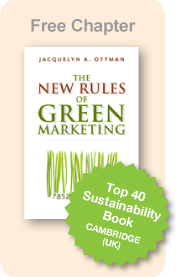Jacquie Ottman's
Green Marketing Blog
Ottman at Sustainable Brands ‘08
June 03, 2008 by assistant

Jacquelyn Ottman and many other sustainability experts gathered in beautiful Monterey California for Sustainable Brands '08. The conference, presented by Sustainable Life Media, is the brand event of the year and has drawn top sustainability experts from across the globe.
On Monday, June 2, Jacquelyn Ottman conducted an exciting and thought provoking workshop on green marketing entitled: Green Marketing 101: There's No Such Thing as a Green Product. Below is a blog posting describing the workshop that I pulled from the SB08 blog. The post was authored by SLM's managing editor, Emily Rabin Cowan. Enjoy!
Green Marketing 101: There's No Such Thing As a Green Product
Don't let the academic title fool you - this was boot camp. Like a drill sergeant keen to instill the basics before her recruits got themselves into trouble, "Green Marketing 101" workshop leader Jacquelyn A. Ottman got off to a quick start: First, how many green-marketing newbies were in the room? About half the hands went up. And the rest? Marketing professionals, high-ranking execs from companies of every possible flavor (Mattel, Nordstrom, and Williams-Sonoma, to name a few), and a Stanford philosophy major writing his thesis on what makes certain ideas catch on.
The Stanford philosopher came to the right session.
There are plenty of reasons why green marketing is such a hot topic right now, chief among them the estimated $209 billion market for green products. Rising energy prices, concerns over climate change and water shortages, health concerns, and economic factors are all driving consumers to reassess the contents of their pantries, closets, and garages. It's the conclusions they come to that's up for grabs.
Will Consumers Pay More for Green Products?
This question provoked a lively debate, with an equal number of workshop participants saying yes and no. One said that despite some additional costs, consumers are pretty savvy about doing the math on savings over time, such as in the case of energy-efficient CFL bulbs. A former Home Depot exec who helped create the home-improvement retailer's Eco Options program countered that based on his experience, "consumers appreciate the idea of green but are not willing to pay a premium for green products."
A few tentative abstainers waited for Jacquie to break the tie. Her answer? "It depends - on efficacy, availability, and awareness."
"We are not here to sell the consumer on saving the planet. This is about ‘saving me' - we are the next endangered species on the list."
~Jacquelyn Ottman
In the absence of green certifications, eco-labels, and other indications of a product's environmental performance, the final decision frequently comes down to corporate reputation, Ottman added. The bigger the brand, the bigger the potential gain - and the potential risk if you don't get it right.
As one workshop participant put it, "We haven't yet effectively calibrated the end value for the consumer." The result? "People are actually kicking back against our green-marketing strategies."
Ottman's "Rules" of Green Marketing
- Consumers must be aware of and concerned about the issues that your product professes to address. Know your customer. If Whirlpool is crowing that its washers don't have CFCs, they better make sure consumers don't think their product is missing something important.
- They have to feel that they'll make a difference by using your product. Otherwise, why bother? Smart marketing programs like the U.S. EPA's Energy Star program educate and equip consumers to make smarter choices.
- They have to believe your claims. Transparency is the best policy. You have nothing to lose and everything to gain by opening your processes to public scrutiny. Conversely, you have everything to lose by keeping them closed, as BP discovered with its over-promising, unverifiable "Beyond Petroleum" campaign.
- The product has to work. Remember those laundry detergents that didn't clean clothes? Reassure the buyer; there may be lingering misconceptions among consumers that you'll have to work extra hard to overcome. Philips learned this the hard way with its Earth Light eco-lightbulb, which consumers mistook for a greenhouse lamp. Philips successfully restaged the brand as Marathon, the lightbulb that last longer - and therefore requires fewer bulb changes.
- If you're charging a premium, the consumer has to feel that it's worth it. Toyota's Prius offers attractive styling, high-tech interior features, and a quieter ride. Also, it's a hybrid. A Prius may offer a seven-year return on investment, but if consumers think they're buying a better car, they won't much care.
Educating the Consumer: The Eco-Labels Debate
There's no such thing as a green product, Ottman cautioned - every product requires materials, uses energy, and creates waste. It's just that one product might have less of these impacts than others (sometimes only under certain circumstances). And it's your job, as a green marketer, to spell this out for consumers in a way that's meaningful to them.
"Government is behind everything in Europe. When you've got NGOs, government agencies, and watchdog groups contributing very actively to the public discussion, you've got a built-in mechanism for greater awareness among consumers."
~Workshop participant based in the U.K.
Ottman encouraged attendees to use trusted, well-known green certification labels such as Energy Star and FSC. Her recommendation to avoid creating an in-house green label met with some opposition from one participant, who noted that companies want to be seen as leaders, which is why they might pursue creating a label such as Home Depot's Eco Options program. What's so wrong with that?
The reason, according to Ottman, is that few labels actually make an impact in consumer purchasing decisions, and the growing trend toward eco-labeling is only confusing the issue. (She posted a slide featuring recycling's "chasing arrows" and took a poll: what does this symbol mean - recycled? Recyclable? Could be either; it's up to the marketer to make the meaning clear through accompanying text.) Fact is, she's not such a fan of Home Depot's Eco Options program, which doesn't offer specific information on product attributes the way, say, Timberland's "nutrition label" or HP's new Eco Highlights label do.
That provoked an unexpected response from the former Home Depot exec, who conceded that Eco Options may have fallen prey to overuse. "It's a question I often asked myself," he said. "How far do you extend it before it loses its value?"
"It's our responsibility not to confuse consumers even more. The fact that we're proliferating these labels is doing a disservice to the real cause - selling product, but also making a difference."
~Workshop participant
Bottom line? There are no cookie-cutter green-marketing strategies, Ottman concluded. "How you develop a distinctive green strategy for your product reflects the specific opportunities and constraints you face."
~Emily Rabin Cowan, SLM Managing Editor
Click here to join our mailing list.



 ShareThis
ShareThis

